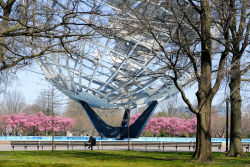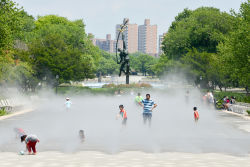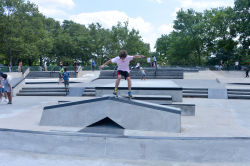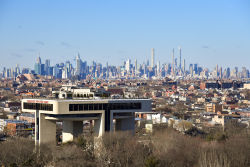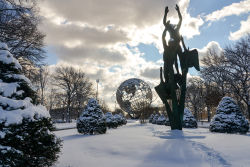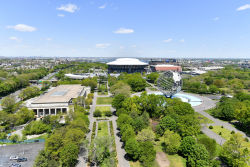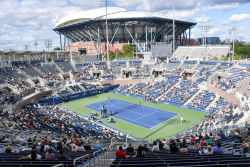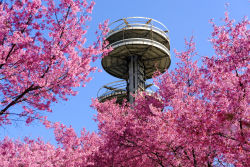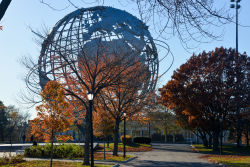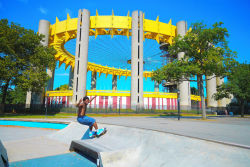Flushing Meadows Corona Park
Flushing Meadows Corona Park
What was here before?
This area was once inhabited by the Matinecocks before the arrival of Dutch settlers in 1640. After the Civil War, the surrounding area became a popular waterfront resort and wealthy New Yorkers built elegant houses nearby. During 19th century industrialization at the turn of the century, the wetlands and creek flowing from Flushing Bay became an ash dump, described in 1925 as a “valley of ashes” in F. Scott Fitzgerald’s Great Gatsby.
How did this site become a park?
In the 1930s, engineer Joseph F. Shagden approached a group of businessmen to organize the 1939-40 World’s Fair. NYC Parks Commissioner Robert Moses (1888–1981) saw potential to rehabilitate the land and create Flushing Meadows Park after the fair ended. The fair, with its theme “The World of Tomorrow,” was a critical if not financial success; featuring the latest technological innovations and visions of the future. The fair was designed with civic improvement in mind. The site was laid out with Beaux Arts radiating pathways inspired by the 1893 Columbian Exposition in Chicago, natural areas, and recreational fields. In the year following the fair, 10,000 trees were planted at the site. Several features from the 1939-40 World’s Fair era survive, including Meadow Lake and its boathouse, nearby Willow Lake, and the New York City Building (now the Queens Museum and formerly the United Nations’ headquarters from 1946 to 1950).
Moses tried again to realize the grand vision for Flushing Meadows when the site hosted the 1964–65 World’s Fair—its theme, “Peace Through Understanding”. Surviving fair structures include the Unisphere, New York State Pavilion, New York Hall of Science, Terrace on the Park, and a public marina at Flushing Bay, which had been built for the 1939 World’s Fair but was expanded for the 1964 World’s Fair. The park is home to 11 major monuments, including Forms in Transit, The Rocket Thrower, and Freedom of the Human Spirit, all dating from the 1964 World’s Fair. There are also two time capsules designed to last 5,000 years buried in the park, marked with a granite monument.
In 1967, the land—renamed Flushing Meadows Corona Park, now the largest in Queens—reverted to the City and was fully landscaped. The park is home to several cultural institutions, including the Hall of Science, the Queens Wildlife Conservation Center, Queens Zoo (part of the Wildlife Conservation Society), Queens Theatre, and Queens Museum. Each year Flushing Meadows Corona Park draws over nine million people from all over the world for both spectator and recreational activities. Major League Baseball’s New York Mets play at Citi Field, which opened in 2009 and replaced Shea Stadium, original home to the Mets since 1964. The Billie Jean King National Tennis Center hosts the United States Open, one of four premiere Grand Slam professional tennis tour events.
The park is additionally supported by the Alliance for Flushing Meadows Corona Park, a private-public partnership. The park’s international flavor shines with annual festivals that draw from the area’s diverse neighborhoods. Today Flushing Meadows Corona Park serves as a local and regional resource to many diverse communities.
What is this park named for?
This park gets its name from two adjacent communities, Flushing and Corona. Flushing, to the east, was a Dutch settlement originally called “Vlissingen,” after a city in the Netherlands. By the mid-1600s, residents had shortened the name to “Vlishing,” which would become “Flushing” with the arrival of British settlers. To the west of the park is Corona. Originally called West Flushing, it became known as Corona in the late 1800s. This name is thought to have come from Italian immigrants who moved into residences developed by the Crown Building Company.
Check out your park's Vital Signs
Clean & Safe
Green & Resilient
Empowered & Engaged Users
Share your feedback or learn more about how this park is part of a
Vital Park System

Know Before You Go

Downloads
- New York State Pavilion Listening Session
- Strategic Framework Plan: Introduction
- Strategic Framework Plan: Site Analysis
- Strategic Framework Plan: Conceptual Framework, Part I
- Strategic Framework Plan: Conceptual Framework, Part II
- Strategic Framework Plan: Vision and Goals, Part I
- Strategic Framework Plan: Vision and Goals, Part II
- Strategic Framework Plan: Appendix, Part I
- Strategic Framework Plan: Appendix, Part II
Links
- National Tennis Center Strategic Vision Project
- World Ice Arena
- Citi Field
- Mets Ticketing
- USTA National Tennis Center
- US Open
- Terrace on the Park Catering Hall
- New York Hall of Science
- Queens Museum
- Queens Botanical Garden
- Queens Theatre
- Queens Wildlife Conservation Center
- Fantasy Forest at the Flushing Meadows Carousel
- Wheel Fun Rentals
- Alliance for Flushing Meadows Corona Park
Contacts
General Park Info: (718) 760-6565
Pitch N Putt Golf and Miniature Golf : (718) 271-8182
World's Fair Marina on Flushing Bay : (718) 478-0480
World's Fair Marina Restaurant: (718) 898-1200
Terrace on the Park: (718) 592-5000
Citi Field: (718) 699-4220
Mets Ticketing: (718) 507-TIXX
USTA National Tennis Center: (718) 760-6200
US Open/USTA: (914) 696-7000
New York Hall of Science: (718) 699-0005
Queens Museum: (718) 592-9700
Queens Botanical Garden: (718) 886-3800
Queens Theatre: (718) 760-0064
Queens Wildlife Conservation Center: (718) 271-1500
Sports Permits: (718) 393-7272
Picnic/Barbeque Permit for Large Groups: (718) 393-7272
Wheel Fun Rentals: (917) 231-5519
World Ice Arena: (718) 760-9001
Al Oerter Recreation Center: (718) 353-7853
Flushing Meadows Corona Park Pool & Rink: (718) 271-7572
Special Events Permits: (718) 760-6560
Tennis Permits: (718) 393-7276
Volunteer Coordinator: (718) 760-6561

